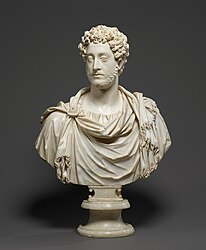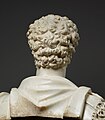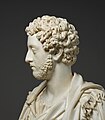Archivo:Bust of Emperor Commodus, front - Getty Museum (92.SA.48).jpg

Ver la imagen en su resolución original (7673 × 9315 píxeles; tamaño de archivo: 6,83 MB; tipo MIME: image/jpeg)
|
|
Este es un archivo de Wikimedia Commons, un depósito de contenido libre hospedado por la Fundación Wikimedia. Más abajo se reproduce su página de descripción con la información sobre su origen y licencia. |
Resumen
Objeto
| Bust of Emperor Commodus
|
|||||||||||||||||||||||||||
|---|---|---|---|---|---|---|---|---|---|---|---|---|---|---|---|---|---|---|---|---|---|---|---|---|---|---|---|
| Artista | |||||||||||||||||||||||||||
| Título |
Bust of Emperor Commodus label QS:Len,"Bust of Emperor Commodus" |
||||||||||||||||||||||||||
| Object type |
escultura |
||||||||||||||||||||||||||
| Género |
busto |
||||||||||||||||||||||||||
| Descripción |
|
||||||||||||||||||||||||||
| Personas retratadas |
Cómodo |
||||||||||||||||||||||||||
| Fecha |
entre 180 y 185 date QS:P,+180-00-00T00:00:00Z/8,P1319,+0180-00-00T00:00:00Z/9,P1326,+0185-00-00T00:00:00Z/9 |
||||||||||||||||||||||||||
| Técnica |
mármol |
||||||||||||||||||||||||||
| Dimensiones |
altura: 69,9 cm dimensions QS:P2048,+69.9U174728 dimensions QS:P2049,+61U174728 dimensions QS:P5524,+22.8U174728 |
||||||||||||||||||||||||||
| Colección |
institution QS:P195,Q180401 |
||||||||||||||||||||||||||
| Ubicación actual |
Gallery 207, Later Roman Sculpture |
||||||||||||||||||||||||||
| Número de inventario |
92.SA.48 (Museo J. Paul Getty) |
||||||||||||||||||||||||||
| Lugar de creación |
Roma |
||||||||||||||||||||||||||
| Referencias |
identificador J. Paul Getty Museum de objeto: 103RSH |
||||||||||||||||||||||||||
Foto
| DescripciónBust of Emperor Commodus, front - Getty Museum (92.SA.48).jpg | Bust of Emperor Commodus, front | ||
| Fuente |
The Getty Center, Object 103RSH
|
||
| Autor | Museo J. Paul Getty | ||
| Permiso (Reutilización de este archivo) |
|
||
| Otras versiones |
|
Leyendas
Elementos representados en este archivo
representa a
image/jpeg
Historial del archivo
Haz clic sobre una fecha y hora para ver el archivo tal como apareció en ese momento.
| Fecha y hora | Miniatura | Dimensiones | Usuario | Comentario | |
|---|---|---|---|---|---|
| actual | 00:50 6 mar 2024 |  | 7673 × 9315 (6,83 MB) | DEGA MD | Uploaded a work by unknown maker from Getty Museum Collection with UploadWizard |
Usos del archivo
La siguiente página usa este archivo:
Uso global del archivo
Las wikis siguientes utilizan este archivo:
- Uso en en.wikipedia.org
- Uso en www.wikidata.org
Metadatos
Este archivo contiene información adicional, probablemente añadida por la cámara digital o el escáner usado para crearlo o digitalizarlo.
Si el archivo ha sido modificado desde su estado original, pueden haberse perdido algunos detalles.
| Información de contacto | rights@getty.edu
www.getty.edu 1200 Getty Center Drive Los Angeles, California, 90049 United States |
|---|---|
| Autor | The J. Paul Getty Museum |
| Título de la imagen |
|
| Título breve |
|
| Crédito/proveedor | The J. Paul Getty Museum, Los Angeles |
| Fuente | The J. Paul Getty Museum |
| Fecha en la cual fueron modificados por última vez los metadatos | 11:09 13 feb 2020 |
| Estado de copyright | No se ha definido el estado del copyright |
| Términos de uso | |
| Declaración de derechos de autor en línea | http://www.getty.edu/legal/copyright.html |
| Comentario de archivo JPEG | Generated by IIPImage |












